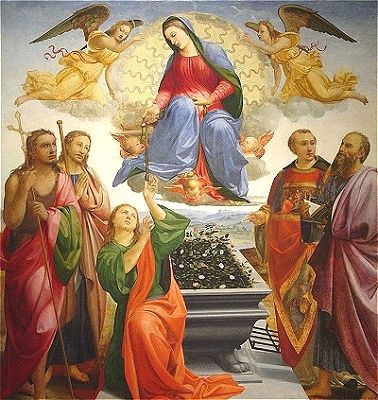THE ASSUMPTION OF THE VIRGIN
SN 24, oil on panelFrancesco Granacci
Italian, 1469-1543 c1515
From "The Pages"
ARTIST:
Granacci was active mainly around Florence. He trained there with Michelangelo in the
workshop of Domenico Ghirlandaio, being considerably influenced by his fellow pupil. Other
influences include Fra Bartolommeo, Leonardo, Raphael, and Pontormo.
SUBJECT:
A Christian legend tells that St Thomas was the apostle who wanted proof of the
Virgin’s Assumption, the term used to denote the taking up to Heaven of Mary’s
soul and body three days after her death. The Virgin lowered her belt (cintola) as proof
to “doubting Thomas.” The legend continues: a crusader returned to Prato (a town
near Florence) from the Holy Land with the belt, which had been given as dowry to his
wife, the daughter of a Greek priest in Jerusalem. The belt was deposited in the Cappella
della Sacratissima Cintola in Prato, which accounts for the popularity of this subject in
Florentine painting. |
|

Click to enlarge
|
The men in the painting are [from the left]:
• St John the Baptist, who foretold Christ’s coming and
baptized him. He is considered to be the last of the Old Testament prophets, and the first
of the New. Frequently seen in Florentine art, he is the patron Saint of Florence. He is
recognized here by his camel hair shirt and reed cross.
• St James, along with Peter and John, was one of the three
apostles closest to Christ, present at the Transfiguration and the Agony in the Garden;
brother to St John the Evangelist and son of Zebedee, a fisherman of Galilee. Patron saint
of Spain, he is said to be buried at Compostella, Spain. Also called the Greater or Elder.
• St Thomas (see above). He also doubted Christ’s resurrection
until convinced by sight and touch.
• St Laurence, in charge of the church’s treasures in the 3rd
century, was instructed by the Pope to give them to the poor. When the Roman Prefect
demanded the treasure, Laurence told him the poor were the church’s treasures. He was
punished by being roasted on a gridiron [shown at his side], during which martyrdom he is
supposed to have said “I’m done on one side, now turn me over.”
• St Bartholomew, another apostle, is said to have traveled as far
as India. While preaching in Armenia he was seized by heathens, flayed alive, then
crucified. Thus one of his attributes is a flaying knife, seen here under the book he is
holding.
PAINTING:
In Renaissance and later painting an Assumption composition was portrayed in two or three
elements, one positioned above the others. The Virgin is shown in mid-air, standing or
enthroned, being carried to Heaven by angels, who sometimes play instruments. She may be
surrounded by a halo (aureole), which radiance seems to emanate from Her. Below on the
ground may be a group of saints, including Doubting Thomas, arranged in a Sacra
Conversazione [sacred conversation among persons who did not actually live at the same
time]. They may be grouped around the Virgin’s empty tomb, which is filled with
lilies or roses. The third element ( not always present) is the image of God above the
Virgin.
HISTORIC CONTEXT:
After spending a short time in Rome, where he assisted Michelangelo in painting the
ceiling of the Sistine Chapel in the Vatican, Granacci returned to Florence. There he
executed this painting for the Medici chapel in San Piero Maggiore. It reflects the
contemporary Florentine style.
Vasari described it as Granacci’s masterpiece, saying that the figure of St. Thomas
could have been painted by Michelangelo himself. Vasari was the leading biographer of the
Italian Renaissance artists, and his book, Lives of the Artists, shaped attitudes toward
this period for centuries to follow.
Additional Bibliography
James Hill, Dictionary of Subjects & Symbols in Art, Harper & Row Publishers, New
York, 1974
George Ferguson, Signs & symbols in Christian Art, Oxford University Press, London,
1954
Museum Label:
The Assumption of the Virgin
c. 1515
Artist: Francesco Granacci
Italian, 1469-1543, active in Florence
Oil on wood panel, 90 x 81 in. (228.6 x 205.7 cm)
According to Christian legend, the Virgin gave her belt, or girdle, to Saint Thomas upon
her Assumption. Said to be housed in a chapel in the city of Prato, this holy relic was
particularly popular in nearby Florence. This painting was commissioned for the family
chapel of the Medici, the city's most powerful and prosperous clan, in the church of San
Piero Maggiore, Florence. The work was extravagantly praised by the sixteenth-century
critic Giorgio Vasari. He wrote that the figures of Saint Thomas and the Virgin were so
full of grace that they were worthy of Michelangelo. Indeed, the poses of these figures
recall the powerful, three-dimensional forms of Michelangelo's paintings.
Bequest of John Ringling, 1936, SN24
ringlingdocents.org
|